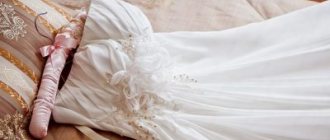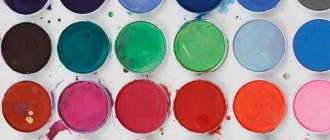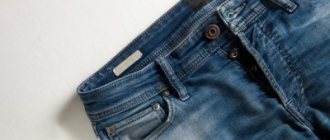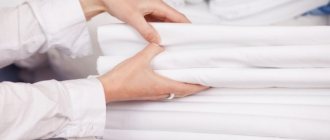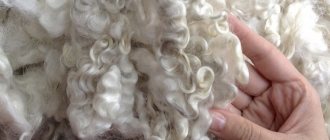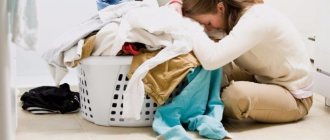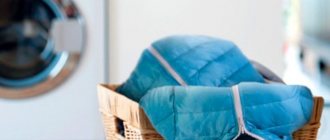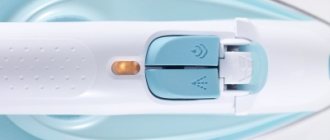Mold contains fungal spores and pathogenic bacteria, which can not only destroy fabrics and clothing, but also penetrate the human respiratory and skin tract, causing a number of unpleasant diseases. Finding it in time on clothes and bedding means protecting yourself and your family members.
The occurrence of fungus is caused by high humidity in cabinets and chests of drawers, in which under no circumstances should you put under-dried items. Even if the item seems to be dry, carefully check the waistbands, collars and cuffs of washed clothes - they need more time to dry.
Causes of mold on clothes
First, let's look at where and under what conditions we store our clothes. Usually it lies in closets and chests of drawers close to each other. As soon as one item, poorly dried after washing, lies in a closed space, a humid microclimate appears there. Mold does not grow in a dry place and where there is good ventilation. Therefore, high humidity is the most comfortable environment for the development of mold mycelium. And in order not to infect other things, you need to follow a few simple rules:
- Take your time to quickly put the washed clothes away in the closets. It may happen that some area of the clothing is not completely dry, for example, the collar of a shirt or a cuff. Over time, in a dark place, this will cause black mold to grow on clothes and in the closet itself.
- An important rule for cleaning rooms is to store dirty things separately from clean ones. After all, you can bring bacteria from the street, thus contaminating clean clothes.
- Periodically leave cabinet doors and drawers open for ventilation.
- In summer, on a dry and hot day, take it out to the balcony and leave winter and warm clothes for a day.
- Be sure to monitor the humidity in the apartment. Mold, also known as fungus, multiplies in conditions of high air humidity.
To prevent mold from growing in your clothes, periodically leave cabinet doors and drawers open for ventilation.
If you do not immediately notice mold on your clothes, and it has managed to grow over a large area of the fabric, this means that the fungus has already penetrated deeply into the fibers.
Sometimes there are irreversible processes, and nothing can remove the mold. The fabrics begin to rot. The item cannot be preserved even after treatment with strong chemicals.
Prevention
Like many problems, mold can be prevented. Following a few simple rules will help you avoid the hassle of mold stains on fabrics.
To do this you need:
- Regularly ventilate the room and cabinets. Fresh air will not only help prevent mold, but also have a positive effect on your health.
- Do not put dirty and clean clothes together. It is advisable to immediately send dirty items to the wash. The risk of mold growing on unwashed items is higher.
- Do not place cabinets and chests of drawers close to the walls. This is especially true for corner rooms.
- Do not rush to put clothes in the closet after ironing. Condensation generated during ironing also represents moisture. It is advisable to wait another 15-20 minutes until the item dries.
- Use moisture-absorbing products. Special bags that absorb moisture will never be superfluous and do not take up much space in cabinets.
What to do if mold appears on things
You took out a towel from the closet that you hadn’t used for a long time and saw traces of mold on it. This is the first signal that a fungus has already settled in this place and, most likely, this is not the only thing affected by spores. Then let's start the fight:
- We take out all the things from the closet and carefully inspect them.
- We sort and put clean and slightly worn items into different piles.
- We re-wash all the clothes, both clean and already worn, because mold may appear later, although it is not yet visible.
- We treat the cabinet itself with alcohol and dry it for as long as possible. Then we ventilate it regularly.
- Next, we place one moisture-absorbing tablet on each cabinet shelf.
Sometimes mold appears on clothes that we put in the washing machine for later washing and we think: “I’ll accumulate more things and wash them all at once.” But the car is a source of high humidity; there is a small air flow inside it. This means that an ideal environment for mold growth appears - warm and humid.
I advise you not to accumulate a lot of laundry and wash it more often. The washing machine itself should be periodically treated from the inside with antibacterial agents and dried after each wash, especially the rubber seals on the door.
Dirty things need to be washed on time without accumulating
Probably, many housewives think that all they have to do is wash fabrics with detergents, and the mold will disappear by itself. However, experience shows that things with a severe stage of infection can only be saved with professional detergents using chlorine-containing preparations and bleach.
Ways to get rid of mold fungus
As you can see, there are many products that clean fabric from mold damage. However, this is not the entire list that can be tested in practice. As mentioned above, the method should be selected depending on your body (the presence or absence of a reaction to chemicals), as well as on the type of tissue.
Undoubtedly, more aggressive chemical compounds will be less easy to remove from fabric, and they should not be used if mold spores appear on a baby’s clothing. It is best to use folk remedies such as vinegar, ammonia, chalk, peroxide, citric acid, laundry soap and even yogurt.
Domestos
If you do not suffer from the above problems and are able to easily tolerate vapors of chlorine-containing substances, then you can use the help of Domestos. Be sure to follow the dosage, because excess product can have a detrimental effect on the structure of even the densest linen or cotton fabric.
Basic procedure:
- Dilute the cleaning solution in a saucepan in a ratio of 15 ml to 2 cups of water.
- Bring the diluted solution to a boil and immerse the contaminated items.
- We wait and watch for the mold to come off the fabric and remove the item.
- Next, you need to rinse thoroughly and wash on a standard cycle or, in the case of cotton, on a high-temperature program (Cotton 90).
How to remove mold from clothes
If mold appears on your favorite item, do not rush to throw it away. You can get rid of fungus using both professional means and folk methods.
Professional products
One way to save your favorite blouse is to take it to the dry cleaner. Mold dies at temperatures above 100 degrees or from the action of strong chemicals. Dry cleaning uses professional bleaches and stain removers.
But you can try to get rid of mold stains at home with the help of Whiteness. It contains chlorine, which serves as both a strong bleach and a disinfectant at the same time. The product works great with white cotton and linen fabrics. Bed linen, underwear, and kitchen towels are soaked in a bleach solution for several hours. To avoid inhaling chlorine vapors, cover the container with a lid while soaking. Some things, especially those seriously affected by fungus, can be boiled with a small amount of bleach. At this time, it is advisable to open the windows for air flow and ventilation.
Whiteness is good at removing mold from white things.
Light-colored cotton fabrics withstand boiling especially well. Colored items may lose color. Mold stains begin to disappear within 10 minutes from the start of boiling. It is not recommended to boil synthetic and woolen fabrics, as they do not tolerate high temperatures well. These fabrics are best treated with stain removers such as Vanish.
It is better to remove mold from synthetic and woolen fabrics using Vanish
Video: removing mold using Dosia gel
Folk remedies
In addition to professional means of combating mold, experienced housewives use many folk remedies in their arsenal, such as soda, vinegar, lemon juice and others.
Lemon juice
If white fabric can be saved by boiling, then colored fabric with unstable dyes is best treated with lemon juice. Mold is afraid of an acidic environment and will not multiply in it.
You can remove mold with lemon juice as follows:
- Apply a few drops of lemon juice to mold stains and leave for half an hour.
- Then sprinkle table salt on top and let dry.
- After this, be sure to wash the clothes in the washing machine with powder or gel.
Lemon juice can remove mold from colored items
Turpentine
Some fabrics can be treated well with turpentine:
- First, pour 1 tablespoon of turpentine over the stain.
- When the product disperses on the fabric, sprinkle cosmetic clay on top. It absorbs turpentine along with the softened fungus.
- Then cover the surface to be treated with clean paper, iron it and put the item in the wash.
Turpentine works great against mold on clothes
Hydrogen peroxide
Hydrogen peroxide can be used to remove mold on fabric. Before use, it is advisable to test the effect on an inconspicuous area of the fabric. If the fabric has not changed color, you can safely apply peroxide to the fungus for half an hour. After the time has passed, wash the clothes.
Hydrogen peroxide can be used to remove mold from fabric.
Ammonia
For colored clothes, you can use ammonia:
- The solution should be applied to the stains and wait 10–15 minutes. This time is enough for the fungal spores to die.
- The clothes should then be washed in the washing machine.
Before using ammonia, you should check how the solution acts on dyed fabric.
Ammonia can be used to remove mildew from colored fabrics
Laundry soap
To remove dirt, you can use laundry soap. The soap contains alkali, which any fungus is so afraid of. When exposed to an alkaline environment, spores cannot reproduce and quickly die.
To remove mold using laundry soap, follow these steps:
- Rub a bar of soap thickly over the mold-damaged area.
- Dip the item into hot water.
- Leave for 2 hours and put in the wash.
Laundry soap is the most affordable folk remedy for removing mold
What to do to prevent the fungus from appearing again
Certain preventive rules should be followed:
- for the necessary air circulation, the cabinet should be moved 2-5 cm away from the wall;
- using hygrometers to monitor the level of humidity in the room or closet;
- after washing, dry the items in the open air, use an iron or steam generator, wait for them to cool for 10-15 minutes;
- After general cleaning, ventilate the wardrobe several times;
- hoods must not be broken;
- disinfection when washing is carried out with powder and soda, using a double rinse mode;
- always dry things on the balcony, put them dry in the closet;
- do not store clean clothes with dirty ones together;
- To protect against fungus, use moisture-absorbing bags;
- Do not store wet items in the laundry basket;
- Dry wet shoes thoroughly after seasonal use and put newspaper inside.
To remove mold, you need to test the product on an inconspicuous area. When dry cleaning, use vodka and soda. To clean delicate fabrics, use turpentine and ammonia. Dry clothes outdoors in direct sunlight.
The article has been verified by the editors
How to remove mold stains from different types of fabrics
Natural fabrics are difficult to treat to remove mold. They have a loose weave and weak fibers. Fungal spores penetrate deep inside and multiply quickly.
Removing mold from wool and silk
Chemical processing is best suited for wool and silk fabrics. If you can’t take your items to the dry cleaner, you can try removing the mold stain with turpentine or ammonia:
- We wet the napkin with the liquid and carefully treat the contaminated area.
- After this, sprinkle a small amount of cosmetic clay on top.
- Iron with a heated iron over the clay through clean paper.
- When the stain is dry, gently wash it in warm water and soap.
Cleaning linen fabrics
Linen and cotton items can be easily cleaned of mold with a simple salt solution:
- For better effect, you can add a few drops of ammonia to this solution.
- The prepared mixture should be applied to the affected area and wait a few minutes.
- Afterwards, the item must be washed thoroughly using powder and rinsed several times.
Saline solution is good at killing mold spores
Getting rid of mold from synthetic fabrics
Synthetic fabrics are also susceptible to the destructive effects of fungus. In this case, experienced housewives use ammonia:
- Dilute a few drops of ammonia in a small amount of water.
- Wet a cotton pad with the resulting solution and treat mold stains.
- Then we wash the product by hand or in the washing machine using gel or powder.
Removing mold from leather products
Mold spores on leather products mainly come from the street, and less often they spread from other household items. Leather is cleaned with the same products as other fabrics. Mechanical force can and should be applied to the skin, since it is a rather dense material.
The cleaning process goes like this:
- First, dry the product well and clean it of dirt.
- Prepare a soap solution and use a medium-hard brush to begin treating the mold stains. The same solution can be prepared with ammonia.
- At the end, simply wash off the residue with warm water and dry thoroughly again.
From white
Removing mold from white products is a difficult and complex process. It may require the use of not one, but several products that will gently clean the item from stains and leave no traces.
How to do it:
- It is necessary to pour hot water into a basin and add 1-2 tablespoons of washing powder.
- Rub mildewed areas with laundry soap.
- Immerse the products in a bowl of water for half an hour.
- After the specified time, you need to wash the item in a machine with the addition of a hydrogen peroxide solution. Add half a liter of water and a tablespoon of peroxide to the soap container.
Preventing mold from growing on clothes
Mold spores multiply quite quickly. At an advanced stage, they already give off a characteristic musty smell that thoroughly permeates both clothing and household items. Therefore, to prevent fungus and odors on things, you should follow certain rules for storing clothes:
- It is not recommended to place the wardrobe close to the wall. The optimal distance from the back of the cabinet to the wall is 6–8 centimeters. This is enough for normal air circulation.
- From time to time you need to ventilate the cabinets by opening doors and drawers for several hours.
- It is advisable to place one moisture-absorbing bag on each cabinet shelf.
- It would be good to periodically inspect things and inspect them for the appearance of mold spores.
- Do not rush to put things back in their places without making sure that the clothes are completely dry. It is better to keep them in the air for an extra hour. Even after ironing with a steam iron, the item has high humidity.
- It is necessary to monitor the humidity level in the apartment.
Cleaning the stroller
If mold appears on clothes, we have discussed how to get rid of it, now you can treat other surfaces, such as a baby stroller. Children's vehicles are most susceptible to mold growth. Naturally, in order to protect your child, you will have to take a number of measures that will remove this scourge.
You need to make a mushy paste using baking soda and plain water. We apply this paste to the moldy areas and remove the spores with a brush. You can also use citric acid or vinegar, and for a powerful effect we remove mold by treating the stroller fabric with turpentine.
- Samsung washing machine error h1
- SMA Samsung error codes
How to remove mold from a bathroom curtain
Almost all bathrooms use curtains and curtains. A negative aspect of this decor is mold, which appears due to remaining moisture in the room. Initially, this is unsightly from a visual point of view and is also dangerous to health.
Once mold has settled on the curtains, it is very difficult to wash it off with just a brush or shower. Therefore, washing would be the best option. A preventative measure for the appearance of fungus on curtains is ventilation. After taking a bath, turn on the hood or simply open the door so that excess moisture does not remain in the room.
Regular washing of curtains and ventilation of the room will prevent the occurrence of mold.
In order to get rid of annoying fungus, use three recommendations:
- Remove the curtains from the hook and brush away easily accessible mildew spots
- Pour warm water into a basin and add 100 g of powder, vinegar and soda each, place the removed curtain in this mixture for 5 minutes
- Remove the curtain from the basin and rinse in cold water
- You can dry the curtain in the dryer for about 15 minutes or with a hairdryer. Point the hair dryer no closer than 5 cm to the curtain
The curtain in the bathroom will definitely become a victim of mold if there is excess moisture in the room
Domestos is also a salvation from mold. If you dilute a capful of the product in 5 liters of water and rub the stains well with a brush, then not a trace of mold will remain.
To prevent mold from growing in the bathroom, try not to leave moisture near the bathroom and on the walls of the room. Wash your curtains at least once a month, even if you do not see mold on the curtains. In addition to mold, other fungi can form on damp curtains. Systematic cleaning of the bathroom will not only keep the room tidy and beautiful, but will also protect your health.
Use of special means
To get rid of mold on clothes, you can use Belizna, Vanish or Domestos.
White
“Whiteness,” also known as labarrack water, is an aqueous solution based on sodium hypochlorite. Not all fabrics can be washed with this product.
Restrictions:
- Do not use for washing black and colored fabrics. The material may lose color.
- Restrictions on the use of chlorine may be indicated in the instructions for the washing machine.
- Use with caution when cleaning clothes with metallic decor. Buttons or cufflinks may become dark.
- Fabric or non-woven material may be susceptible to chlorine and chloride compounds.
“Whiteness” is a strong remedy, but it is not suitable for all types of fabrics.
Important! “Whiteness” is only suitable for white wardrobe items.
Carefully study the labels on clothing. If there are marks with a crossed out triangle or a triangle with two lines parallel to one of the sides, you cannot use “Whiteness”!
Algorithm of actions:
- Make sure the bleach is suitable for the machine and fabric.
- If possible, remove metal elements from clothing.
- Soak the items in a bowl of water, add half a glass of the product.
- Leave for several hours.
- Place it in the washing machine as usual.
- Rinse and dry in fresh air.
Note! If there are non-removable metal decorative elements, it is worth reducing the con.
Vanish
Vanish Oxi Action is a universal stain remover that copes well with all types of stains, including pathogenic microflora. The product does not contain optical brighteners, so it can wash any fabric, light or colored. The only exception is woolen items and silk items.
Advantages:
- Suitable for colored and light-colored fabrics.
- Suitable for machine and hand wash.
- High efficiency.
- Allows you to remove any type of dirt.
- Low cost.
- Economical: one glass is enough for three machine washes.
“Vanish” has both advantages and disadvantages.
Flaws:
- Do not use with products containing chlorine compounds.
- Not suitable for wool and silk.
Important! Do not use with products containing chlorine and its compounds.
Domestos
Domestos, like Vanish, is a universal stain remover. Including effectively eliminating mold. However, the product contains sodium hypochlorite, so it is worth considering the “chlorine” restrictions described in the “Whiteness” section.
Domestos should be used with caution and take into account the limitations.
Why does mold appear?
The musty smell and mold stains appear due to dampness. If clothes hang in a closet with high humidity or lie in the machine for a long time after washing, the fabric becomes a favorable environment for the growth of fungus and other pathogenic microflora. How it appears is clear.
It remains to decide how to remove mold from affected wardrobe items and what means are more effective to get rid of fungal spores.
The main cause of stains is dampness.
